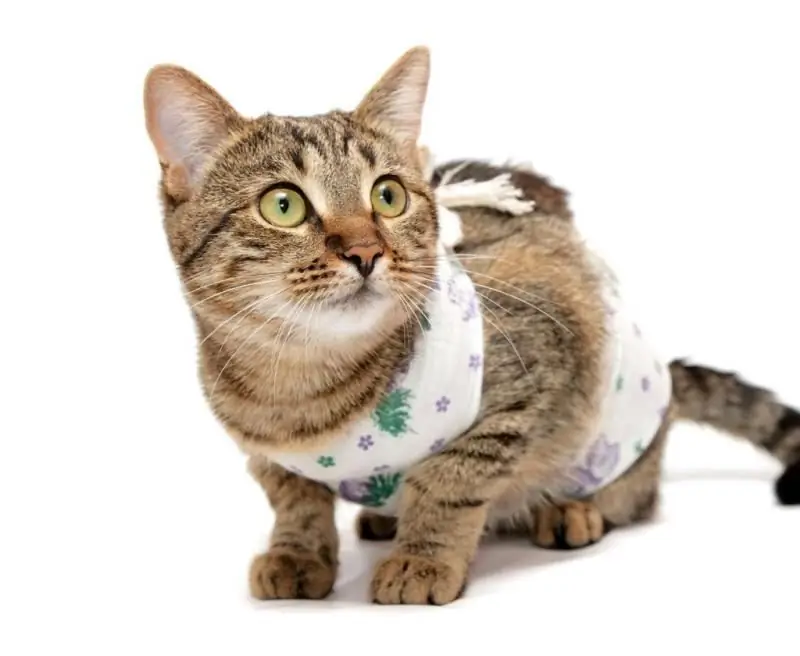
Table of contents:
- Author Bailey Albertson [email protected].
- Public 2023-12-17 12:53.
- Last modified 2025-06-01 07:32.
A blanket for a cat is an important wardrobe item to protect your pet

Rare cat owners create a personal wardrobe for their pet. Unlike dogs of decorative breeds, representatives of felines are not so tolerant of clothing and the very process of putting on and wearing it. But in some cases, clothes in the form of a blanket can be useful - after operations, to protect the animal while walking on the street. Here it is worth taking care of the relevance of such an item of clothing for your pet and the rules for its choice.
Content
-
1 Types of blankets and their purpose
-
1.1 Postoperative blanket
- 1.1.1 Selection rules
- 1.1.2 How to use the blanket correctly after surgery
-
1.2 Protective blankets
- 1.2.1 Warm blanket
- 1.2.2 Blankets-raincoats
-
-
2 How to make a do-it-yourself postoperative blanket for a cat
- 2.1 Pattern
- 2.2 Material selection and sewing
-
2.3 Alternatives
2.3.1 Video: blanket from a sock or stocking
- 3 What to do if a cat takes off her blanket
Types of blankets and their purpose
Blankets are of several types, depending on their purpose - postoperative and protective (warm and waterproof).
Postoperative blanket
In the postoperative period, it is necessary to protect the seams from licking - cats tend to lick their wound, gnaw out surgical threads, which greatly complicates and lengthens the healing period. In addition, dirt and dust should not get into the intervention area, and given that animals actively move around the house and are in the darkest corners, this can be difficult. A special postoperative blanket solves the described tasks. It should be acquired if the following interventions were carried out:
- castration of a cat (removal of the ovaries or ovaries together with the uterus in order to prevent further reproduction);
- surgery on the organs of the digestive system (stomach, intestines, etc.);
- operations on the organs of the urinary system (kidneys, bladder, etc.).
Also, the blanket can be useful if the pet has a dermatological disease on the chest or abdomen - in such a situation it will protect against scratching and licking damaged areas, applied topical preparations and spreading the affected area.

Postoperative blanket for a cat helps to protect the wound after abdominal surgery from licking and dirt
Selection rules
The first rule to purchase a postoperative blanket is to make sure it is necessary. In some cases, it is simply impossible to close the wound, therefore it is better to clarify this issue with the doctor who will perform the surgical intervention. If you need a blanket, then you should choose it based on several criteria at once:
-
the size. When buying, you should focus on the measurements of your pet. They need to be done in advance by measuring the volume of the cat's chest and the distance from the shoulders to the base of the tail. The size of the blanket will be indicated on the package, and if you pick it up correctly, then the animal will not press or interfere with anything;

Blanket packing On the packaging of the blanket, its size and measurements of the animal are indicated, taking into account which it is designed
- Colour. When choosing a color, it is primarily not about the decorative value of the acquisition, but about the practical side of the issue. So, on light-colored fabrics it is easier to see the presence of secretions, and it is also easier to establish when the blanket is dirty and it is time to change it;
- quality of tailoring. All seams must be strong, without protruding threads, you should also pay attention to the quality of the ribbons for fixing - it is important that they do not quickly disheveled and deteriorate, otherwise you will have to purchase a new blanket;
- the width of the ties. Considering that the postoperative blanket is fixed with tapes on the animal's back, they should be wide. If the strings are too thin, then they can interfere, rub the skin, causing significant discomfort to the cat;
- packaging. The blanket is an item that will come into contact with a wound on the body of an animal, therefore it should be sold in an individually sealed package without signs of opening. It is optimal if the pack is completely transparent - this way you can evaluate all important parameters from color to the quality of the seams.
How to properly use a blanket after surgery
After sterilization or other abdominal surgery, a medical blanket is immediately put on the animal. It is better if the doctor does it for the first time and shows you how to tie the object on the cat correctly. In the process of putting on, you should be especially careful, since the wounds after the operation hurt, and the animal will be extremely unpleasant for sharp and careless actions on the part of the owner. The blanket is put on as follows:
- The tissue part is applied to the tummy, wound up by the front paws, and the ribbons are brought up onto the cat's back.
-
The ribbons need to be tied in turn:
- the first and second pairs are tied around the neck, in the area up to the front legs;
- the third pair is tied immediately behind the paws and connected to the tails of the second pair;
- the fourth and fifth pairs of ties are located on the back, the last one is closest to the hind legs;
- two ribbons remain on each side - they are tied together in pairs, bending around the cat's thigh with a ring. The ends of both pairs on both sides are tied together on the back, in front of the tail.
- It is necessary to check the strength of the blanket fixation - it should not slip, and at the same time, it should not be strongly pinched the animal's body. The belt tension needs to be adjusted.

The blanket is tied with several pairs of straps on the back of the cat for the best fit
You will have to change the blanket regularly in the first days after the operation, after processing the stitches at least once a day. When the wound begins to heal and the discharge stops, you can change the bandage as it gets dirty. It will be possible to completely abandon the blanket after sterilization of the cat no earlier than 10-14 days. It is better to do this after a veterinarian examination, which is routinely carried out after operations.
Protective blankets
Blankets can be used not only for medical reasons, there are other options that perform a decorative and protective function.
Warm blanket
A warm blanket is useful for cats that are especially sensitive to low temperatures - these are primarily breeds without hair (sphinxes). Protection is also useful for pets, which are released outside or taken with them on a vacation in nature. The main purpose of such a feline wardrobe item is to protect against hypothermia. To do this, the construction uses a heater (synthetic winterizer), and the model itself is as closed as possible. Unlike postoperative blankets, warm blankets completely cover the back and sides, fastening from the bottom.

A warm blanket helps to avoid hypothermia, which is especially important for hairless cats.
Blankets-raincoats
Raincoat blankets are useful for animals that go outside. They are made by analogy with human raincoats - the upper layer consists of a water-repellent waterproof material, and the bottom can be either just a light fabric lining or a warmed lining. Such a blanket will protect the pet's body from getting wet and dirty, which will greatly simplify the care of the coat after a walk.

Raincoats protect the animal from water and dirt getting on the coat
How to make a DIY postoperative blanket for a cat
Considering that several blankets will be required in the postoperative period, you can save money and make them yourself.
Pattern
It all starts with measuring the pet. The following measurements are required for sewing:
- girth of the neck;
- chest girth;
- girth of the abdomen at the hind legs;
- girth of paws;
- length from neck to base of tail.
Next, you can start building the pattern itself. Basically, the blanket is the fabric that covers the cat's belly and chest with paw slots and ties on top. Based on the data obtained about the size of your pet, you need to build such a complex figure. The length of the strings is calculated based on the girth of the body, but it is better to do them with a margin - when the finished blanket is already put on the cat after the operation, it is better to cut off the excess tails of the ribbons than to fix too short strings.

The blanket pattern is built according to the measurements of the animal and involves the complete closure of the abdomen with recesses for the paws
Material selection and sewing
The materials for the blanket should be natural and allow air to pass through well, so ordinary cotton would be an excellent option (it should not be shabby, it is better to choose high-quality fabric). A good solution would be a multi-layer construction: the top layer is decorative, the inner one can be made of jersey or flannel. In the place where the seam will be located, you can sew an additional layer of fabric - it will serve as a lining and absorb the protruding ichor.
The fasteners should be from 5 to 7 pairs, otherwise the bandage will not be well fixed, and the cat will be able to get out of it. The simplest option is fabric ribbons 1.5-2 cm wide, which will be tied with bows. If you wish, you can equip them with Velcro - then putting on a blanket will be somewhat easier. The parts cut out according to the patterns in the required quantity are simply stitched together. In the places where the strings are attached, it is better to stitch several times - this will make their attachment to the blanket stronger. Before using the finished postoperative blanket, be sure to wash and iron it with a steam iron.
Alternative options
If the blanket is needed urgently, and there is no way to either buy it or sew it on purpose, then you can make a simple option that is perfect for the first time. This will require:
- Take a long sock or sleeve from a jersey. Cut off the excess, leaving only the tissue tunnel corresponding to the measurements of the animal from the neck to the tail.
- Cut openings for the front and hind legs so that when putting on the fabric does not block the space under the tail and does not interfere with the cat going to the toilet.
- The alternative blanket is ready. The downside is the difficulty of putting it on - it will have to be pulled through the entire body of the animal, which must be done extremely carefully because of the seams.
Video: blanket from a sock or stocking
What to do if a cat takes off her blanket
Usually cats are quite negative about wearing blankets, especially given their desire to lick their wounds. Even with good fixation, sometimes animals manage to remove the bandage. In this case, the owner needs to inspect the seam - if the cat managed to lick it, severe redness, bleeding, etc. appeared, then you should immediately go to the doctor, and if everything is in order with the wound, then it will be enough to put on the blanket again. If the episodes of withdrawal are repeated, then you should follow these recommendations:
- try to tie the bandage tighter and follow the animal - perhaps the bands do not fix the bandage tightly enough;
- check the quality of the ribbons themselves - if they are made of smooth material, then the bows can be easily untied;
- perhaps the blanket simply does not fit in size or has an insufficient number of ties. In this case, you will have to make or buy a new one with better fixation.
The blanket can be useful both for beauty and insulation in the cold season, and in the postoperative period, when it is necessary to protect the seam from licking by animals and dirt. You can buy such a device at a pet store, or you can sew it yourself at home.
Recommended:
How To Wash A Blanket At Home, Is It Possible To Use A Washing Machine, Which Mode To Choose + Photos And Videos

What materials are blankets made of? Natural and artificial fabrics. How to wash them in the washing machine or by hand. Proper storage
Cat Litter: How To Choose The Best, Types (clumping, Absorbent), Ever Clean, "Golden Cat", "Barsik" And Others, Reviews
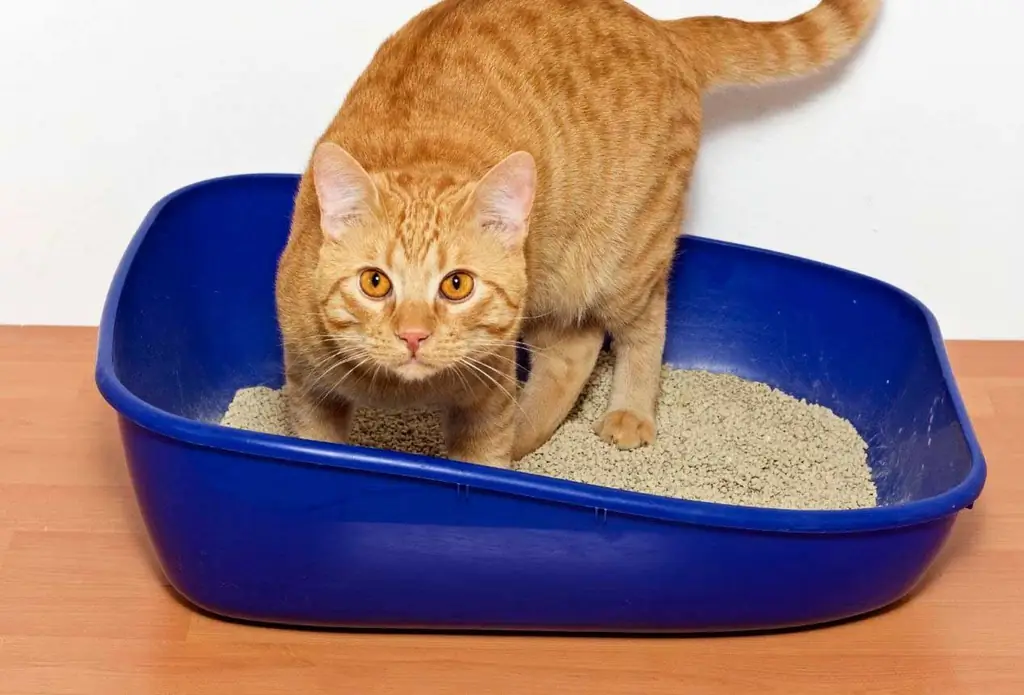
How to choose the right cat litter. What are the types of fillers, their advantages and disadvantages. Review of popular brands. Reviews
Carrying For Cats And Cats: Varieties (bag, Backpack, Plastic, Cage And Others), How To Choose, How To Do It Yourself, Reviews
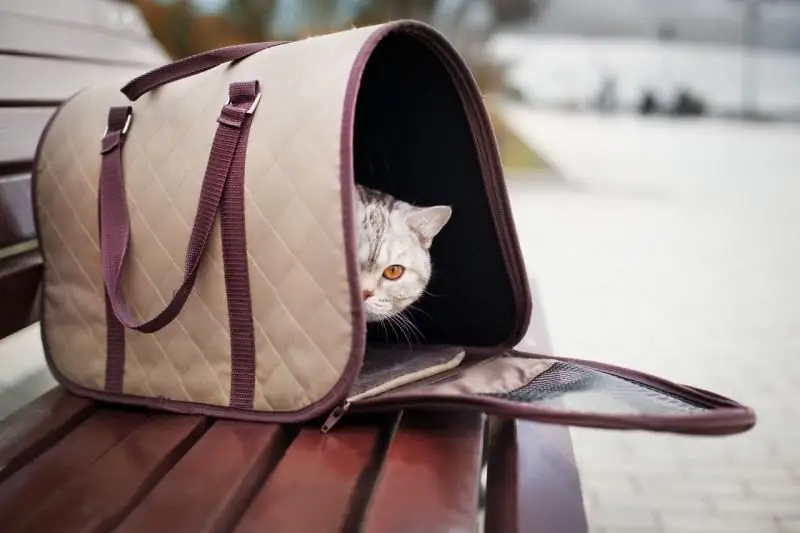
Types of carriers for cats. Recommendations for their selection. How to train your cat to carry. How to make an accessory yourself. Video. Photo
Cystitis In Cats And Cats: Symptoms (blood In Urine And Others) And Treatment At Home, Medications (pills And Others), Veterinarian Advice
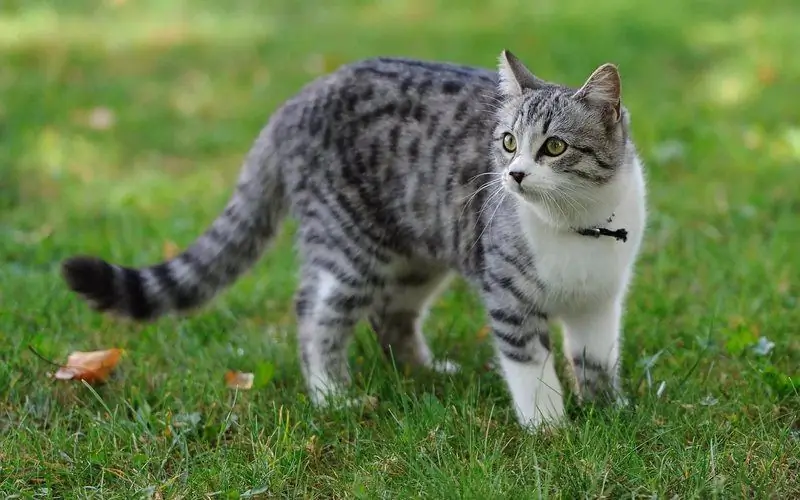
What causes cystitis, its symptoms, course forms, diagnosis, treatment. Caring for a sick cat, prevention of cystitis
Caring For A Cat After Sterilization: Pet Behavior, How Long It Takes To Recover From Anesthesia, How Many Days It Will Take To Recover, Advice And Feedback
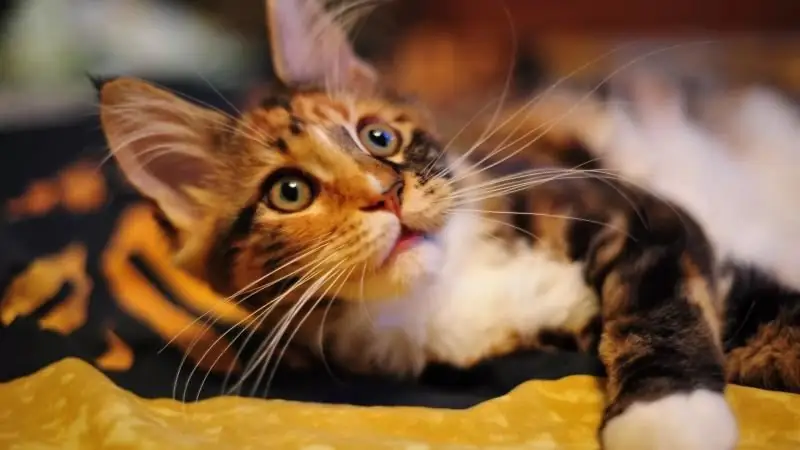
Why sterilization is needed. Methods for neutering a cat. Caring for her at home. Possible complications. The condition of the cat in the early days. Further behavior
